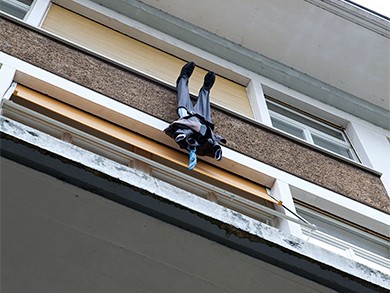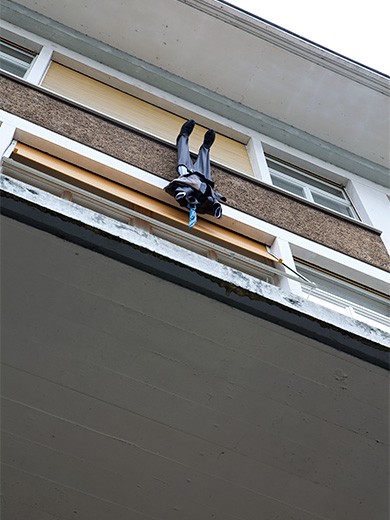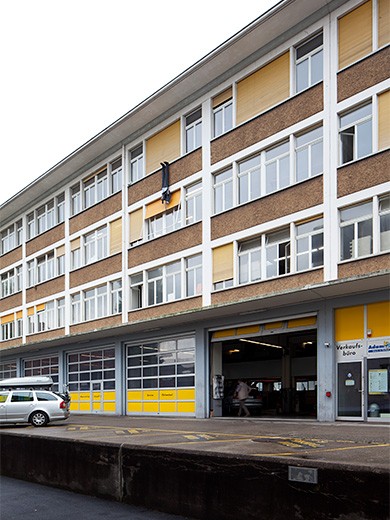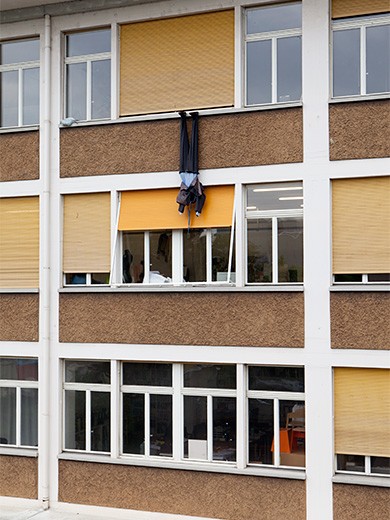Nevin Aladag
Neulich, 1997/2015

Die US-amerikanische Fernsehserie Die Sopranos beginnt mit einer überraschenden, für die Figur des Mafioso Toni Soprano aus New Jersey jedoch prototypischen Szene. Das Oberhaupt einer kriminellen Familie von Italoamerikanern windet sich im Sessel von Dr. Melfi bei seiner ersten Therapiesitzung und muss einsehen: Er hatte eine Panikattacke. Ein Resultat seiner tiefsitzenden Angst zu versagen, der Unfähigkeit, Schwäche zu zeigen und einem ganzen Paket an familiären und geschäftlichen Problemen. Kurzum, er steckt in der Krise.
Die Berliner Künstlerin Nevin Aladag (*1972, TR) hat 1997 erstmals eine Arbeit realisiert, die nicht nur den Zustand von persönlicher Krise thematisiert, sondern diese auch innerhalb grösserer, sozioökonomischer Zusammenhänge verankert: An der Fassade eines Hochhausesam Berliner Ernst-Reuter-Platz hängt die vollständige Montur eines Anzugträgers – schwarze Lederschuhe, dunkelgraue Hose und Jackett, Hemd und Schlips – kopfüber aus einem Fenster. Eines fehlt jedoch: der Körper. Zuunterst weht die Krawatte im Wind. Rücklings an der Fassade baumelnd, löst die Attrappe nicht die Assoziation eines freien Falls aus; vielmehr erinnern wir sofort all jene Filmszenen, in denen eine Gruppe Mafiosi jemanden von einem Dach oder aus einem Fenster hängen lässt, um aus ihm die vermeintlich zurückgehaltenen Informationen herauszuholen. Die Anzugfigur steht mithin für jemanden in Gefahr, der unter Druck gesetzt und von äusseren Umständen in eine prekäre Lage gedrängt wird.
Eine bemerkenswerte Verschiebung innerhalb des von Aladag zitierten Bildes bleibt die Abwesenheit des eigentlichen Körpers. In Neulich finden wir nur noch den leeren Business-Anzug, als ob der Körper aus ihm geglitten wäre. Wie eine Fahne bewegt sich die leere Hülle an der Hausfassade, einer Trauerbeflaggung gleich, die von bereits geschehenem Unglück zeugt. Bewusst setzte Aladag, damals noch Bildhauerei-Studentin, an die Fassade die leere Hülle einer menschlichen Figur. Wie reagiert die Öffentlichkeit? Welche Diskussionen kommen unter den Mitarbeitern im Hochhaus auf?
Auffällig ist darüber hinaus, mit dem Abstand von heute annähernd 20 Jahren, dass sich schon in Neulich Aladags Interesse zeigt, in existierende Strukturen und Bilder einzudringen, um mittels formaler Verschiebungen grössere inhaltliche und gesellschaftliche Zusammenhänge offenzulegen. Dieser Teil ihrer Praxis bildet bis heute ein Charakteristikum, das sie in vielen ihrer Arbeiten weiterentwickelt hat.
Toni Soprano war erstmals 1999 im amerikanischen Fernsehen zu sehen und eröffnete die Möglichkeit einer psychologischen Aktualisierung des klassischen Mafioso. Nevin Aladag wiederum hatte zwei Jahre zuvor die Figur des «Corporate Businessman» seziert und von ihm nur eine entkörperlichte Hülle zurückgelassen. Ihre für den Aussenraum konzipierte Installation musste nach nur wenigen Tagen in das Treppenhaus verlegt werden. Die ursprüngliche Präsentation sorgte für zu viel Aufregung im Stadtbild. Ungewollt wurde die Diskussion zu einer von Aladag thematisierten individuellen wie auch kollektiven Krise metaphorisch und ganz konkret in das Innere der Firma verschoben. Nico Anklam
Courtesy the artist, Wentrup Gallery (Berlin)
und Rampa Gallery (Istanbul)
Dank an Thomas Welti
English Version
The television series “The Sopranos” from the USA begins with a scene that is surprising, but prototypical of the mafioso character Toni Soprano from New Jersey. This head of a criminal family of Italian Americans contorts in a chair during his first therapy session with Dr Melfi and has to accept that he has had a panic attack. This is a result of his ingrained fear of failure, of an inability to show weakness, and of a whole range of family and business problems. In short, he is in a crisis.
In 1997, the Berlin-based artist Nevin Aladag (b. 1974, Turkey) produced a work, which, for the first time, not only thematised the state of -personal crisis, but also anchored it within wider socio-economic contexts: on the facade of a high-rise at Berlin’s Ernst-Reuter-Platz, the complete outfit of a suit-wearer (black leather shoes, dark-grey trousers and jacket, shirt and tie) hangs out of a window, upside down. However, one thing is missing: the body. At the very bottom, the tie waves in the wind. Dangling with its back to the facade, the mockup does not conjure up any associations with a free fall; instead, we are immediately reminded of all those film scenes, in which a group of mafiosi have someone -suspended from a roof, or out of a window, in order to extract supposedly withheld information. The suited figure thus represents someone in danger, who is under pressure and forced into a precarious situation by external circumstances.
Within the image invoked by Aladag, there remains one noticeable shift: the absence of the actual body. In Neulich (which means “Recently”), we find only the empty business suit, as if the body had slipped out of it. The empty shell moves around on the building’s facade like a flag at half-mast, bearing witness to misfortune that has already occurred. Aladag, who was still a sculpture student at the time, placed the empty shell of a human figure on the facade quite consciously. How does the public react? What discussions arise among those who work in this high-rise?
Moreover, now that almost 20 years have passed, it is noticeable that Aladag’s interest in the penetration of existing structures and images for the purpose of revealing wider content-related and social contexts by means of shifts in form is already evident in Neulich. This aspect of her practice constitutes a characteristic that she has developed further in many of her works to this day.
Toni Soprano was seen on American television for the first time in 1999 and opened up the possibility of a psychological update of the traditional mafioso. Two years earlier, on the other hand, Nevin Aladag had dissected the character of the “corporate businessman” and left behind only his disembodied shell. After only a few days, her installation, which was conceived for the outdoor space, had to be moved into the stairwell. The original presentation caused too much commotion in the cityscape. Inadvertently, the discussion about an individual and collective crisis that was thematised by Aladag, was metaphorically and quite tangibly shifted into the interior of the company. Nico Anklam
Courtesy of the artist, Wentrup Gallery (Berlin) and
Rampa Gallery (Istanbul)
Thanks to Thomas Welti


